Clemson University
Clemson University (/ˈklɛmp.sən, ˈklɛm.zən/[5][6][note a]) is a public, land-grant research university in Clemson, South Carolina. Founded in 1889, Clemson is the second-largest university in student population in South Carolina. For the fall 2017 semester, the university enrolled a total of 19,402 undergraduate students and 4,985 graduate students,[3] and the student/faculty ratio was 18:1.[7] Clemson's 1,400-acre campus [8] is in the foothills of the Blue Ridge Mountains and sits next to Lake Hartwell. The university manages the nearby 17,500-acre Clemson Experimental Forest that is used for research, education, and recreation.
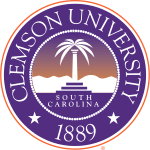 | |
Former names | Clemson Agricultural College of South Carolina (1889–1964) |
|---|---|
| Type | Public Land-grant university Sea-grant university |
| Established | 1889 |
| Endowment | $774.5 million (2019)[1] |
| President | James P. Clements |
| Provost | Robert H. Jones |
Academic staff | 1,431[2] |
Administrative staff | 3,451[2] |
| Students | 24,951 (2018)[3] |
| Undergraduates | 19,669[3] |
| Postgraduates | 5,282[3] |
| Location | , , United States 34°40′42″N 82°50′21″W |
| Campus | Suburban 1,400 acres |
| Colors | Clemson Orange, Regalia[4] |
| Nickname | Tigers |
Sporting affiliations | NCAA Division I – ACC |
| Mascot | The Tiger, The Cub |
| Website | www |
 | |
Clemson University consists of seven colleges: Agriculture, Forestry and Life Sciences; Architecture, Arts and Humanities; Business; Behavioral, Social and Health Sciences; Education; Engineering, Computing and Applied Sciences; and Science.[9] U.S. News & World Report ranks Clemson University tied for 24 among all national public universities.[10] Clemson University is classified among "R1: Doctoral Universities – Very high research activity."[11]
History
Beginnings
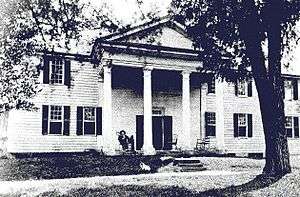
Thomas Green Clemson, the university's founder, came to the foothills of South Carolina in 1838, when he married Anna Maria Calhoun, daughter of John C. Calhoun, a slaveholder, South Carolina statesman and seventh U.S. Vice President.[12] When Clemson died on April 6, 1888, he left most of his estate, which he inherited from his wife, in his will to be used to establish a college that would teach scientific agriculture and the mechanical arts to South Carolinians.[13] His decision was largely influenced by future South Carolina Governor Benjamin Tillman. Tillman lobbied the South Carolina General Assembly to create the school as an agricultural institution for the state and the resolution passed by only one vote.
In his will, Clemson explicitly stated he wanted the school to be modeled after what is now Mississippi State University: "This institution, I desire, to be under the control and management of a board of trustees, a part of whom are hereinafter appointed, and to be modeled after the Agricultural College of Mississippi as far as practicable."[14]
Clemson Agricultural College of South Carolina
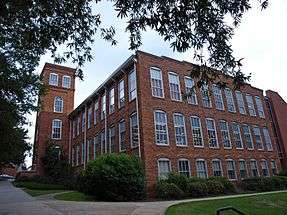
In November 1889, South Carolina Governor John Peter Richardson III signed the bill, thus establishing the Clemson Agricultural College of South Carolina. As a result, federal funds for agricultural education from the Morrill Land-Grant Colleges Act and the Hatch Act of 1887 were transferred from South Carolina College (today, the University of South Carolina) to Clemson.[12] Construction of the college began with Hardin Hall in 1890 and then main classroom buildings in 1891. Henry Aubrey Strode became the first president of Clemson from 1890 to 1893. Edwin Craighead succeeded Strode in 1893. Clemson Agricultural College formally opened in July 1893 with an initial enrollment of 446. The common curriculum of the first incoming students was English, history, botany, mathematics, physics and agriculture. Until 1955, the college was also an all-white male military school.
.png)
On May 22, 1894, the main building (Tillman Hall) was destroyed by a fire, which consumed the library, classrooms, and offices. Tillman Hall was rebuilt in 1894 and is still standing today. The first graduating class of Clemson was in 1896 with degrees in mechanical-electrical engineering and agriculture. Clemson's first football team began in 1896 led by trainer Walter Riggs. Henry Hartzog, graduate of The Citadel, The Military College of South Carolina, became president of Clemson in 1897. Hartzog created a textile department in 1898. Clemson became the first Southern school to train textile specialists. Hartzog expanded the curriculum with more industrialization skills such as foundry work, agriculture studies and mechanics. In 1902 a large student walkout over the use of rigid military discipline escalated tensions between students and faculty forcing Hartzog to resign. Patrick Mell succeeded Hartzog from 1902 to 1910.[15]
Following the resignation of Mell in 1910 former Clemson Tigers football coach Walter Riggs became president of Clemson from 1910 to 1924.[16] The Holtzendorff Hall, originally the Holzendorff YMCA, was built in 1914 designed by Rudolph E. Lee of the first graduating class of Clemson in 1896. In 1915 Riggs Field was dedicated after Walter Riggs and is the Clemson Tigers men's soccer home field. During World War I enrollment in Clemson declined. In 1917 Clemson formed a Reserve Officers' Training Corps and in 1918 a Student Army Training Corps was formed. Effects of World War I made Clemson hire the first women faculty due to changes in faculty.[17] Riggs accepted a six-month army educational commission in 1919 overseas in France leaving Samuel Earle as acting president. On March 10, 1920 a large walkout occurred protesting unfair "prison camp" style military discipline. The 1920 walkout led to the creation of a Department of Student Affairs. On January 22, 1924 Riggs died on a business trip to Washington, D.C. leaving Earle the acting president. In October 1924 another walkout of around 500 students occurred when Earle rejected their demands of better food and the dismissal of mess officer Harcombe and the reinstatement of their senior class president. The 1924 walkout resulted in 23 students dismissed and 112 suspended.

On April 1, 1925 a fire destroyed the interior of the agricultural building and with it many research projects and an agricultural museum. The exterior of the building survived, leading to the construction of Sikes Hall to hold the library from Tillman Hall. On May 27, 1926 Mechanical Hall was destroyed in a fire. Present-day Freeman Hall, built in 1926, was the reconstructed shop building. In 1928 Riggs Hall was established in honor of Walter Riggs.[18] President Enoch Sikes increased student enrollment by over 1,000 students and expanded the degree programs with an addition of the first graduate degree. The Department of Arts and Sciences was formed in 1926 with the addition of modern languages programs. Programs at Clemson were reorganized into six schools of agriculture, chemistry, engineering, general science, textiles, and vocational studies. In 1927 Clemson received accreditation from the Association of Secondary Schools and Colleges of the Southern States.
During The Great Depression student enrollment and income declined. The New Deal brought needed construction to the campus under the Works Progress Administration with new dormitories to relieve the housing shortages. Long Hall, Sirrine Hall, and 29,625 acres of privately owned farmland was acquired by Clemson through federal funding. Agricultural engineers of Clemson diversified with the Clemson Agricultural Extension to educate farmers on soil conservation and crop storage techniques during The Great Depression. Robert Poole became the first Clemson alumnus to be president in 1940. On September 19, 1942 Memorial Stadium was formally opened as the new stadium for the Clemson Tigers football team who previously played on Riggs Field since 1915.[19]
During World War II more than 6,500 students were sent overseas in the military. As a result of the Clemson ROTC, around 5,850 were commissioned officers. The class of 1943 had a historical low of 343 graduates.[20] By the end of the war, 376 Clemson students had been killed in it.
Becoming civilian and coeducational and desegregated
In 1955 Clemson underwent a major restructuring and was transformed into "civilian" status for students. It began admitting white women; the university was still segregated.[21]
In 1963, the school admitted its first African-American student, Harvey Gantt, who later was elected as mayor of Charlotte, North Carolina.[22]
Clemson University
In 1964, the college was renamed Clemson University, as the state legislature formally recognized the school's expanded academic offerings and research pursuits.[23]
In 2015, students protested against Tillman Hall being named for "a powerful white supremacist". The Board of Trustees voted against renaming the building.[24] In 2020, the trustees petitioned the state legislature to remove Ben Tillman's name from the building, at the same time it renamed the honors program, which had been named for John C. Calhoun.[25]
Campus
Academics
| College | 2017 |
|---|---|
| College of Agriculture, Forestry and Life Sciences | 2,137 |
| College of Architecture, Arts and Humanities | 1,994 |
| College of Behavioral Science and Health Science | 3,633 |
| College of Business | 4,589 |
| College of Education | 1,509 |
| College of Engineering, Computing and Applied Sciences | 7,056 |
| College of Science | 3,276 |
Admissions
Admission to Clemson is rated "more selective" by U.S. News & World Report.[26]
For the Class of 2022 (enrolling Fall 2018), Clemson received 28,845 applications and accepted 13,613 (47.2%), with 3,792 enrolling.[27] The middle 50% range of SAT scores for enrolling freshmen was 610-690 for reading and writing, and 610-710 for math.[27] The middle 50% ACT composite score range was 27-32.[27] The average high school grade point average (GPA) was 4.43.[27]
Research and rankings
|
|
| ||||||||||||||||||||||||||||||||||||||||||||||||||||||||||||||||||||||

The university endeavors to become a "Top 20" public institution, undergoing a process of enhancing its graduate programs while continuing to emphasize the quality of the undergraduate experience. It has steadily moved up the rankings for public universities from 34,[39] to 30,[40] to 27,[41] to 22[42] in 2005, 2006, 2007, and 2008 respectively, according to the U.S. News & World Report. In 2012, U.S. News & World Report ranked Clemson as the 25th top public school in the U.S.,[43] and in 2015 the ranking improved to a tie for 21st. As of 2019, Clemson is ranked tied for 27th.[10]
However, some have questioned Clemson's efforts to improve its rankings. In 2009, an administrator revealed that "Clemson manipulated class sizes, artificially boosted faculty salary data and gave rival schools low grades in the rankings' peer reputation survey", with the goal of manipulating its U.S. News & World Report ranking. Since then the administrator retracted some of her statements and the university denied any wrongdoing.[44]
The renowned economist Robert Tollison joined the Clemson faculty in August 2008. As part of its push to enhance graduate-level education, several new Ph.D. programs have been created including interdisciplinary doctoral programs in Rhetorics, Communication, and Information Design (RCID), and Planning, Design, and the Built Environment (formerly Environmental Design and Planning). Also noteworthy is a new master's degree in historic preservation, jointly offered in collaboration with the College of Charleston.
The university is home to the Clemson University International Center for Automotive Research (CU-ICAR).[45] The CU-ICAR is a 250-acre (101 ha) automotive and motorsports research campus in nearby Greenville, South Carolina. The department of Automotive Engineering was ranked 10th in the world in 2015.[46] ICAR will include a graduate school offering master's and doctoral degrees in automotive engineering, and offering programs focused on systems integration. The campus also includes an Information Technology Research Center being developed by BMW. BMW, Microsoft, IBM, Bosch, The Timken Company and Michelin are all major corporate partners of the CU-ICAR. Private-sector companies that have committed to establishing offices and/or facilities on the campus include the Society of Automotive Engineers and Timken. Plans for the campus also include a full-scale, four-vehicle capacity rolling-road model wind tunnel.
In 2004 the Restoration Institute was founded. Its mission is to "advance knowledge in integrative approaches to the restoration of historic, ecological, and urban infrastructure resources." The institute is in North Charleston and subsume the Hunley Commission that is undertaking the stabilization of the H.L. Hunley, the world's first submarine to sink a ship. As of 2013, the institute is constructing a 7.5MW and a 15MW wind turbine test facility for $100 million, to open on November 21.[47][48]
In 2016, Clemson announced a new partnership with Siemens, including a grant with a total value of $357,224,294. This grant is the largest in the school's history. Through it, students in Clemson's College of Engineering, Computing and Applied Sciences will have access to a variety of new software.[49]
In 2011, The Princeton Review ranked Clemson 1st for town-gown relations are great, 2nd for happiest students, 2nd for jock schools, 3rd for everyone plays intramural sports, 8th for students pack the stadiums, and 9th for best career services.[50]
In 2012, SmartMoney named Clemson University as 7th best salary returns on tuition.[51]
In 2012, U.S. News ranked Clemson University 3rd for having the most financial resources per student. $26,293 was spent on the average student at Clemson University.[52]
In 2015, Clemson University broke ground on the Zucker Family Graduate Education Center in the City of North Charleston. The 70,000 sq.ft. facility is estimated to cost more than $22 million.[53]
In 2016, The Princeton Review ranked Clemson University number one in three categories: Student Career Services, Town-Gown Relations, and Students pack the stadium.[54]
Colleges and schools
In July 1955, the four schools that made up Clemson ― Agriculture, Arts & Sciences, Engineering and Textiles ― were transformed into nine colleges: Architecture, Arts and Sciences, Liberal Arts, Sciences, Commerce and Industry, Education, Engineering, Forestry and Recreation Resources, and Nursing.[55] This structure was used by the university until 1995 when the university's nine colleges were condensed into five: Agriculture, Forestry, and Life Sciences; Architecture, Arts, and Humanities; Business and Behavioral Science; Engineering and Science; Health, Education, and Human Development.[56] As of 14 July 2014, the Eugene T. Moore School of Education broke off from the College of Health, Education, and Human development, thus becoming the sixth college.[57]
An academic reorganization effective July 1, 2016 created seven new colleges: College of Agriculture, Forestry and Life Sciences; College of Architecture, Arts and Humanities; College of Behavioral, Social and Health Sciences; College of Business; College of Education (including the Eugene T. Moore School of Education); College of Engineering, Computing and Applied Sciences; and College of Science.[58]
College of Agriculture, Forestry, and Life Sciences
The College of Agriculture, Forestry and Life Sciences (CAFLS) supports Clemson University's land-grant mission to provide education, research and service to the public. CAFLS faculty members teach major subjects and core curricula while preparing students to be leaders, creative thinkers, and communicators. Emphasis is placed on engaging students in research, internships/coops, study abroad, and service learning. CAFLS research is focused on the sustainability of agriculture, forests, and natural resources; food and packaging systems to ensure a healthy and safe food supply; and biomedical sciences to improve human and non-human health.[59]
College of Architecture, Arts, and Humanities
The College of Architecture, Arts, and Humanities (CAAH) contains three schools: the School of the Arts, the School of Design and Building, and the School of the Humanities. Within these schools are ten departments: Art, Architecture, Construction Science and Management, English, History, Landscape Architecture, Languages, Performing Arts, Philosophy and Religion, and Planning, Development, and Restoration.[60] One of the departments of the college, the School of Architecture, was ranked as the No. 16 graduate school for architecture in the country by Design Intelligence.[61] The Brooks Center serves as performing arts venue for the college.[62]
College of Business
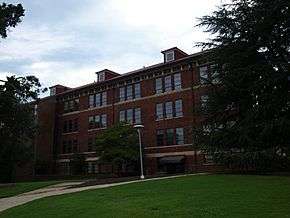
The College of Business is accredited by the Association to Advance Collegiate Schools of Business.
College of Engineering, Computing and Applied Sciences
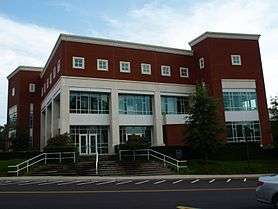
The College of Engineering, Computing and Applied Sciences specializes in engineering as well as the physical sciences such as physics and chemistry. Inspired by Thomas Green Clemson's dream to create a "high seminary of learning to benefit the agricultural and mechanical arts," engineering and sciences have been an integral part of the university's development. Since the first degrees were granted in 1896, Clemson engineers and scientists have made significant contributions to South Carolina, the nation and the world.
CoES was formed in 1995, joining the engineering disciplines with the chemistry, computer science, geological science, mathematical science, and physics and astronomy departments.[63]
College of Health and Human Development
The College of Health and Human Development focuses on public health sciences, nursing, education, and parks, recreation and tourism management.[64]
Clemson University Honors College
The Clemson University Honors College focuses on education for highly motivated, academically talented students. Entrance to the college is very competitive, with only 250 incoming freshmen accepted each year with an average SAT score of 1400 or higher and finished in the top 3% of their high school graduating class.[65] The college was founded in 1962 and originally named for John C. Calhoun, a South Carolina native and politician, who was the vice president of the United States from 1825-1832 and an ardent supporter of slavery. Students, alumni, and others had been pressing the university to change the college's name for several years when it was renamed in 2020 during the George Floyd protests.[25]
College of Education
The College of Education is Clemson's newest college. It is centered in the famous Tillman Hall. The college has some 600 undergraduate students, and 600 graduate students, with the mission to embrace the diverse faculty, staff, and students and providing them with a diverse set of experiences. The COE also houses the Call Me MISTER Program and the Moore Scholars.[66]
On June 12, 2020, university trustees petitioned the state legislature for authorization to rename Tillman Hall. “Pitchfork” Ben Tillman was a governor and U.S. senator who used virulent racism to dominate South Carolina politics after Reconstruction.[67]
Graduate School
The Graduate School offers more than 100 graduate degree programs in 85 disciplines on the college's main campus and at sites such as Clemson at the Falls, the Clemson University International Center for Automotive Research and the Clemson Architecture Center as well as some online/distance-learning programs. Many of the graduate programs are highly ranked nationally, and the school offers several unique interdisciplinary programs.[68]
International Center for Automotive Research
The Clemson University International Center for Automotive Research (CU-ICAR) was established in 2013 in Greenville as a seminary for automotive research and innovation. The center is a collaboration with BMW.[69]
Student life
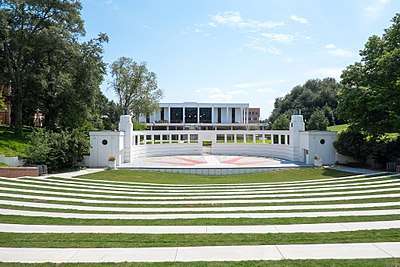
Intramurals
In addition to their varsity programs, Clemson offers a wide variety of intramural sports:[70]
Fraternity and sorority life
The university's fraternities and sororities system (or Greek system) is somewhat different from other large universities in the southern U.S. in that there are no Greek houses on campus, as interfraternity activity did not begin until 1970, following the abolishing of the military cadre requirements at the university. There are residence halls designated for fraternities and sororities, but there are no traditional Greek houses on campus. However, there are a few fraternity houses off campus near the college. The Fraternity Quad on campus (consisting of seven fraternity and sorority halls) is certified by the U.S. Green Building Council's Leadership in Energy and Environmental Design (LEED) program. The remaining sororities' on-campus housing is on the other end of campus, in what is commonly referred to as "the horseshoe," in Smith and Barnett Halls.
The College Panhellenic Council Chapters at Clemson University include Alpha Phi, Alpha Chi Omega, Alpha Delta Pi, Chi Omega, Delta Delta Delta, Delta Zeta, Gamma Phi Beta, Kappa Alpha Theta, Kappa Delta, Kappa Kappa Gamma, Pi Beta Phi, Sigma Kappa, and Zeta Tau Alpha.[71] The Interfraternity Council Chapters include Alpha Gamma Rho, Alpha Sigma Phi, Alpha Tau Omega, Beta Theta Pi, Beta Upsilon Chi, Chi Phi, Delta Chi, Delta Tau Delta, FarmHouse, Kappa Alpha Order, Kappa Sigma, Pi Kappa Phi, Phi Gamma Delta, Phi Delta Theta, Phi Sigma Kappa, Sigma Nu, Theta Chi, Tau Kappa Epsilon, Psi Upsilon, and Triangle.[72]
As of the fall 2017 semester there are twenty IFC Fraternities, thirteen NPC Sororities, eight NPHC Chapters, and four MGC Chapters, which make up approximately 23 percent of the undergraduate student body.
In 2017 15% of men and 31% of women were involved in Greek life, out of 19,825 undergraduate students.[73] While the required GPA to join Greek life is 2.7, the mean GPA of each sorority was above the all-university mean.[74]
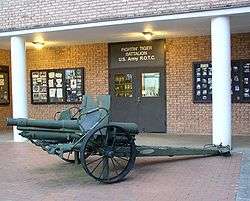
Military heritage
Although the university became a coeducational civilian institution in 1955, it still maintains an active military presence. Cadets still participate during home football games, during which cadets hold the ropes as the team enters from the Hill, and they complete pushups for every Clemson point scored, just as the Tiger does.
The university is home to detachments for U.S. Army and U.S. Air Force Reserve Officers' Training Corps (ROTC) as well as a host school for the U.S. Marine Corps PLC program adjacent to the Semper Fi Society.
In addition to students from the university, these organizations also serve students from Anderson University, Southern Wesleyan University, and Tri-County Technical College. The following organizations are present among the military personnel at Clemson:[75]
- Company C-4 Pershing Rifles
- K-7 Scabbard and Blade
- Maj. Rudolf Anderson, Jr Squadron Arnold Air Society (AAS)
- Maj. Dennis H. Satler Chapter Silver Wings
- Clemson Rangers
The university's AAS squadron was selected to be home of Arnold Air Society's National Headquarters for the 2005–2006 year, and again for the 2006–2007 year. This is the first time in AAS's history that any university has served as national headquarters two years in a row.[76] The squadron again serves as national headquarters for the 2015-16 school year.
The C-4 Pershing Rifles have won the national society's drill meet nine times: 1999, 2003, 2004, 2005, 2006, 2008, 2009, 2011, and 2017.[76] Company C-4 also performs colorguards, twenty-one-gun salutes, exhibition-drill performances, and POW/MIA ceremonies. Company C-4 performs colorguard performance at the university's home football games. In addition to the C-4 drill company, the university is the former home of the 4th Regimental Headquarters (4RHQ), the National Headquarters for the Junior ROTC level of Pershing Rifles (BlackJacks) and the Co-ed Auxiliary for Pershing Rifles (CAPeRs).
Its Air Force ROTC Detachment 770 "Flyin' Tigers" was selected as the No. 1 "medium-sized" Air Force ROTC detachment in the nation for 2006 (the "High Flight" and "Right of Line" awards), No. 1 Detachment in the "Southeast" in 2006 ("medium-sized") and 2007 ("large-sized"), and No. 1 in the state of South Carolina (out of three—University of South Carolina and The Citadel) for three consecutive years (2005, 2006 and 2007).
The university has also developed a group of Marines and Marine Officer Candidates within an organization called the Semper Fi Society. The society is not associated with the ROTC, but can lead to a commission into the U.S. Marine Corps via the Platoon Leaders Course program.
Student media
Clemson University has seven completely student-run media outlets. These organizations operate under Tiger Media, the university's student media department, and are each on the third floor of the Hendrix Student Center. These include The Tiger, The Tiger Town Observer, Tigervision, TAPS Yearbook, The Pendulum, The Chronicle, The Sensible Tiger, and WSBF-FM.[77]

Founded in 1907, The Tiger is the oldest student-run newspaper in South Carolina. The Tiger publishes local and university related news pieces. Additionally, the paper publishes opinion articles on general and national issues, lifestyle articles on topics such as food, sex, and music. With sports being a major part of Clemson University's culture and events, The Tiger also contains a large sports section focusing on football, basketball, baseball, and soccer. The Tiger is published weekly, on Mondays, and maintains a staff of 20 senior members and 75 junior staff members.[78]
The Tiger Town Observer is a conservative news magazine that focuses on university politics. The magazine identifies itself as a "traditionally conservative" news source and lists its political values as liberty, transparency, lifelong learning, free market and charity.[79]
Tigervision, Clemson's student-run TV station, broadcasts on channel 88 on the university's campus cable network. The station was created in 1994 under the name Clemson Cable Network by students at WSBF-FM who were interested in television production. The station aired a variety of student created content as well as recently released movies via a licensing agreement. By 2006, after experiencing a decline in membership and viewers, CCN was no longer consistently producing content and fell into relative obscurity. However, in 2007, CCN was reorganized into Clemson Television and began to produce student comedy shows as well as airing public domain films. As content quality began to increase, so did membership. In 2014, CTV was renamed Tigervision to coincide with its switch to high definition broadcasting.[80]
TAPS Yearbook was established in 1907 after members of the Clemson College Chronicle, the literary arts magazine at the time, wanted to publish a new book printed annually. It is named after the song "Taps", which was played each night when cadets went to bed during the college's time as a military school. Each edition of TAPS contains student portraits, information on student organizations, and reviews of the past year's events.[81] In 2017, TAPS announced the end of the 2017-18 academic year would mark the final edition of the yearbook. Its student media group will replace it with a quarterly interest magazine beginning in fall 2018.[82]
WSBF-FM was founded in 1958 and made its first broadcast on April 1, 1960. In the beginning, WSBF's content was mostly agriculture education shows and classical music. By the mid-1960s, the station began to air sports programs such as The Frank Howard Show along with news. The station would eventually shift to a "progressive" format where it focused on new, up-and-coming contemporary music groups. During the 1980s, the format would shift gradually changed to the station's current "alternative" format. WSBF plays a variety genres including jazz, rap, punk, rock, and folk focusing on independent artists. The station broadcasts to the Clemson area and upstate South Carolina on 88.1 FM as well as online.[83]
The Chronicle is a literary art magazine that publishes biannually. It was founded in 1897 and prints student created content ranging from poetry, short stories, photography, and drawings.[84]
The Pendulum is a student-run international affairs magazine. It was established in 2014 and officially joined Tiger Media the following year. It publishes twice a year during the fall and focuses on international politics, economics, and global affairs. The Pendulum often takes these topics and discusses how they affect students and the Clemson community.[85]
The Sensible Tiger is a student-run weekly newsletter established in 2018 which provides students with brief, non-partisan news in an effort ease political divides on campus. The Sensible Tiger has interviewed 2019 Democratic candidate Beto O'Rourke and Washington Post contributor Josh Dawsey, and produces a biweekly Spotify podcast entitled "The Watercooler."
Traditions
Tiger Paw
The Tiger paw became the official logo for Clemson University in 1970, in place of the previous tiger logo. The change was inspired by President Robert Edwards to "upgrade the image of the university." The Tiger Paw logo was introduced at a press conference on July 21, 1970. It was created by John Antonio and developed by Helen Weaver of Henderson Advertising in Greenville, South Carolina, from a mold of a Bengal tiger sent to the agency by the Field Museum of Natural History in Chicago. The paw is now used on all athletic teams and collegiate documents. The tiger paw is also painted on surfaces throughout campus and on highways leading to the campus.[86]
Homecoming and Tigerama
Every year Clemson students have the opportunity to attend Homecoming and Tigerama. The Clemson Homecoming tradition began in 1914 and has been held annually at Clemson University ever since. During homecoming week, various student organizations design and build Homecoming floats on Bowman Field. The floats are then revealed on the Saturday of the football game and judged by a select panel. Since 1957, Clemson has held "Tigerama" on the Friday night of homecoming week. Tigerama is one of the nation's largest student-run-pep rallies, averaging about 40,000 people. This Clemson event includes the crowning of Miss Homecoming, skits by various academic organizations, as well as a fireworks show.[87] [88]
First Friday Parade
The First Friday Parade has been held on the Friday before the first home football game every year since 1974. The parade includes fraternities, sororities, the Clemson marching band, the university President, as well as many other student organizations. The parade route travels through portions of Highway 93 and Main Street and concludes at the university's amphitheatre, where the first pep rally of the year is held. In 1985, the parade had its highest attendance, when accompanying CBS commentators were the Grand Marshalls.[87][89]
Alma mater
The Clemson University alma mater originated in the 1910s after a group of Clemson ROTC cadets in May 1918 was asked to sing the school's song at a gathering of ROTC cadets in Plattsburgh, New York; they were unable to do so, as Clemson had no song at the time. One of the cadets in attendance, A.C. Corcoran of Charleston, South Carolina, decided to remedy the situation and wrote the words to the alma mater and set them to Annie Lisle, which was the melody of Cornell University's alma mater, as well as many others. The words were later officially accepted by the then-named Clemson Agricultural College as the alma mater and was first performed by the Clemson Glee Club on February 17, 1919.[90]
In 1947 the club "Tiger Brotherhood" decided that, rather than continue borrowing another school's melody, the university should compose its own. As a result, the Tiger Brotherhood sponsored a contest to have Clemson students compose a unique melody. On May 5, 1947, Clemson University's school newspaper "The Tiger" announced Robert E. Farmer of Anderson, South Carolina, a member of the glee club at the time, as the winner. Farmer's melody was slightly altered in 1970, but was restored to its original tune in 2009.[90]
Fight song
The university's fight song is the jazz standard, the "Tiger Rag".[91]
Memorial Stadium traditions
Athletics
Clemson University teams are known as the Tigers. They compete as a member of the National Collegiate Athletic Association (NCAA) Division I level (Football Bowl Subdivision (FBS) sub-level for football), primarily competing in the Atlantic Coast Conference (ACC) for all sports since the 1953-54 season. Men's sports include baseball, basketball, cross country, football, golf, soccer, tennis and track & field; while women's sports include basketball, cross country, golf, rowing, soccer, diving, tennis, track & field, softball and volleyball.
The most-prominent athletics facilities on campus are Memorial Stadium, Littlejohn Coliseum, Doug Kingsmore Stadium, Historic Riggs Field, and Fike Recreation Center. Clemson has won six national championships including three in football (1981, 2016 and 2018), two in men's soccer (1984 and 1987), and men's golf (2003).
 Memorial Stadium
Memorial Stadium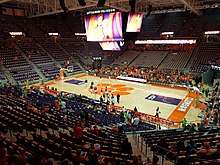

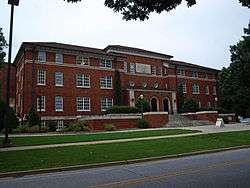
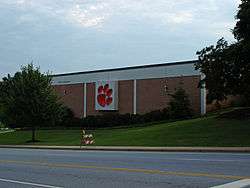
Public safety
Clemson University operates with the Clemson University Police Department and the Clemson University Fire & EMS for public safety needs. Both departments are staffed 24 hours a day, 7 days a week. The Clemson University Fire & EMS has one station, at 1521 Perimeter Road. The Police Department is located at 124 Ravenel Center Place, Seneca.
Notable alumni
- Major Rudolf Anderson Jr. Class of 1948, was the only person killed by enemy fire during the Cuban Missile Crisis.[92]
- David Beasley, South Carolina governor (1995–1999)[93]
- Kris Benson, baseball player[94]
- Jay Berger (born 1966), tennis player; highest world ranking # 7
- Robert H. Brooks, founder of Hooters of America, Inc.[95]
- Jonathan Byrd, PGA Tour golfer.[96]
- James F. Byrnes, U.S. Congressman, Senator, U.S. Supreme Court Justice (1941–1942), Secretary of State (1945–1947), Governor of South Carolina (1951–1955), and confidant of President Franklin D. Roosevelt.
- Dwight Clark, former American football wide receiver with the San Francisco 49ers, played on two Super Bowl championship teams and was a two-time All-Pro.
- Chad Connelly, Chairman of the South Carolina Republican Party[97]
- Brian Dawkins, Pro Football Hall of Famer, played eight times in the Pro Bowl.[98]
- Dave Dondero, American singer-songwriter/guitarist
- Lt. Col. Jimmie Dyess, of the United States Marine Corps, the only person in history to earn both the Congressional Medal of Honor and the Carnegie Medal of Honor
- Ekwee Ethuro, Speaker of the Kenyan Senate
- Harvey Gantt, First Black Mayor of Charlotte.
- Lucas Glover, PGA Tour golfer, 2009 U.S. Open champion
- Nikki Haley, former Governor of South Carolina[99] and former United States Ambassador to the United Nations
- James M. Henderson, advertising executive in Greenville; Republican candidate for Lieutenant Governor of South Carolina in 1970.[100]
- Stuart Holden, soccer player, Sunderland, Bolton Wanderers; played for the USA team in the 2010 FIFA World Cup
- DeAndre Hopkins, football player, Arizona Cardinals, All-Pro wide receiver and 27th overall pick in the 2013 NFL Draft
- Rob Huebel, actor
- Kristie A. Kenney, United States Ambassador to Thailand and former Ambassador to The Philippines
- Brad Miller, Philadelphia Phillies infielder
- Rory "McAlister" Murray, WWE Wrestler and member of The Highlanders
- Nancy O'Dell, American television host and entertainment journalist
- Oguchi Onyewu, retired professional soccer player
- William "Refrigerator" Perry, former NFL defensive lineman, three-time NCAA All-American (1982–1984)
- Ben Robertson, war correspondent in World War II, author
- Brianna Rollins, track and field athlete, 2016 Summer Olympics gold medalist
- Phillip Sandifer (writer, recording artist) received a master's degree from the university
- Jim Speros, formerly the majority owner of the Baltimore Stallions of the CFL, UFL Norfolk; youngest assistant coach in NFL history
- C. J. Spiller, football player, 9th overall pick in the 2010 NFL Draft
- Strom Thurmond, U.S. Senator from South Carolina who was the longest-serving Senator in U.S. history
- Sammy Watkins, football player, Kansas City Chiefs wide receiver and 4th overall pick in the 2014 NFL Draft, 2020 Super Bowl Champion
- Deshaun Watson, football player, drafted 12th overall in the 2017 NFL Draft by the Houston Texans, Pro Bowl QB
- Shawn Weatherly, Miss Universe 1980
- David H. Wilkins, former U.S. Ambassador to Canada; former Speaker of the South Carolina House of Representatives, the first Republican Speaker in the South since Reconstruction
- Vanessa E. Wyche, Deputy Director of the JSC[101]
Notable faculty
- Thomas Hazlett, Hugh H. Macaulay Endowed Professor of Economics (since 2014); co-author of "Public Policy Toward Cable Television"
- John W. Huffman, Research Professor of Chemistry and creator of many synthetic cannabinoid compounds, including JWH-018, one of the main ingredients in Spice (drug).[102]
- Jo Jorgensen, United States Libertarian Party candidate for President of the United States in the 2020 United States presidential election and candidate for vice-president in the 1996 United States Presidential Election
with Matthew L. Spitzer (MIT Press, 1987) and author of "The Political Spectrum" (Yale U. Press, 2016)
- Donald Liebenberg, Adjunct Professor of Physics and Astronomy; known for his work related to solar eclipses
- Michael J. Padilla, former Director of the Eugene T. Moore School of Education
- June Pilcher, Alumni Distinguished Professor of Psychology
- Apparao M Rao, Professor of Physics
- David Reinking, Eugene T. Moore Professor of Education (since 2003); co-editor of Reading Research Quarterly, a peer-reviewed journal published by the International Reading Association
- Robert Tollison, Professor of Economics
- Antony Valentini, Professor in the Department of Physics and Astronomy
- Victor J. Vitanza, Professor of Rhetoric
Footnotes
- ^Note a: The local, authoritative pronunciation of Clemson is [klɛmpsən]. Because of the pin–pen merger in Southern American English, [ɪ] can be substituted for [ɛ] as the first vowel, as [klɪmpsən]. Those not familiar with the local pronunciation often say [klɛmzən] or [klɛmsən], as the spelling would suggest. See generally The Routledge Handbook of Contemporary English Pronunciation.
References
Notes
- As of June 30, 2019. "U.S. and Canadian 2019 NTSE Participating Institutions Listed by Fiscal Year 2019 Endowment Market Value, and Percentage Change in Market Value from FY18 to FY19 (Revised)". National Association of College and University Business Officers and TIAA. Retrieved April 18, 2020.
- "Clemson University Fact Book" (PDF). Clemson.edu. Retrieved 30 December 2018.
- "Clemson University Interactive Factbook". Clemson University Office of Institutional Research. Retrieved October 12, 2019.
- "Color Palette". Clemson University Brand Guide. Retrieved March 26, 2017.
- The Routledge Handbook of Contemporary English Pronunciation, Okim Kang, Ron I. Thomson, John M Murphy eds. Routledge. 2017.
- Jones, Daniel. English Pronouncing Dictionary. Cambridge University Press. 2006. p.96.
- "Clemson University - Niche". Niche. Retrieved 2018-05-03.
- "About | Clemson University, South Carolina".
- "The University Today – Clemson University". Archived from the original on April 28, 2007. Retrieved June 20, 2007.
- "Top Public Schools National Universities". U.S. News & World Report. 2019.
- "Carnegie Classifications – Institution Lookup". Center for Postsecondary Education. 2016. Retrieved January 15, 2016.
- "History of Clemson University". Clemson University. Retrieved 3 November 2011.
- "Thomas Green Clemson 200 - The Will." Clemson University. Retrieved 17 September 2011.
- "The Will of Thomas Green Clemson".
- Riley, Helene. Clemson University. Arcadia Publishing.
- "Walter M. Riggs Presidential Records Series.0017". Retrieved 5 February 2017.
- Lusk, Brock. "Tigers in the Trenches: A Study of Clemson in the Great War". Retrieved 5 February 2017.
- "History of the Department". Retrieved 5 February 2017.
- "Memorial Stadium". collegegridirons.com. Retrieved 5 February 2017.
- "Military History at Clemson". clemson.edu. Retrieved 5 February 2017.
- "Clemson University Board of Trustees Manual" (PDF). clemson.edu. Retrieved 5 February 2017.
- "Harvey Gantt and the Desegregation of Clemson University; an Online version of an exhibit presented by the Library in conjunction with "Integration With Dignity: A Celebration of 40 Years" on January 28, 2003". Retrieved January 21, 2011.
- "The History of Clemson University". Retrieved June 20, 2007.
- Svrluga, Susan (March 26, 2015). "UNC students demand new name for building honoring a KKK leader". Washington Post.
- Connolly, Matt (June 12, 2020). "Clemson's Calhoun Honors College has a new name after pushback". The State. Archived from the original on June 12, 2020. Retrieved June 12, 2020.
- "U.S. News Best Colleges Rankings: Clemson University". U.S. News & World Report. 2017. Retrieved January 12, 2017.
- "Clemson University Common Data Set 2018-2019, Part C" (PDF). Clemson University.
- "Academic Ranking of World Universities 2020: National/Regional Rank". Shanghai Ranking Consultancy. Retrieved August 15, 2020.
- "America's Top Colleges 2019". Forbes. Retrieved August 15, 2019.
- "U.S. College Rankings 2020". Wall Street Journal/Times Higher Education. Retrieved September 26, 2019.
- "Best Colleges 2020: National University Rankings". U.S. News & World Report. Retrieved September 8, 2019.
- "2019 National University Rankings". Washington Monthly. Retrieved August 20, 2019.
- "Academic Ranking of World Universities 2020". Shanghai Ranking Consultancy. 2020. Retrieved August 15, 2020.
- "QS World University Rankings® 2021". Quacquarelli Symonds Limited. 2020. Retrieved June 10, 2020.
- "World University Rankings 2020". THE Education Ltd. Retrieved September 14, 2019.
- "Best Global Universities Rankings: 2020". U.S. News & World Report LP. Retrieved October 22, 2019.
- "Clemson University - U.S. News Best Grad School Rankings". U.S. News & World Report. Retrieved August 4, 2019.
- "Clemson University - U.S. News Best Global University Rankings". U.S. News & World Report. Retrieved August 4, 2019.
- "U.S. News & World Report". August 28, 2005: 111–115. Cite journal requires
|journal=(help) - "U.S. News & World Report". August 29, 2006: 80–84. Cite journal requires
|journal=(help) - "U.S. News & World Report". August 27, 2007. Cite journal requires
|journal=(help) - "U.S. News & World Report". August 22, 2008. Cite journal requires
|journal=(help) - "Top Public Schools | Rankings | Top National Universities | US News". Colleges.usnews.rankingsandreviews.com. Archived from the original on 2011-10-08. Retrieved 2011-10-08.
- Pope, Justin (June 7, 2009). "Clemson official: School manipulated rankings". USA Today. Retrieved 11 September 2012.
- "Clemson University International Center for Automotive Research (CU-ICAR)". Retrieved June 20, 2007.
- "Top 10 Automotive Engineering Schools In The World In 2015". Just Engineering Schools. 2014-05-30. Retrieved May 30, 2014.
- PJ Randhawa. "State investigating investment into wind energy" Clemson Energy, July 17, 2013. Accessed: September 28, 2013.
- "Wind Turbine Drivetrain Testing Facility Archived 2013-10-01 at the Wayback Machine" Clemson Energy. Accessed: September 28, 2013.
- "Siemens provides Clemson with largest in-kind technology grant in university history". Retrieved 11 January 2017.
- "Clemson University." 2011. The Princeton Review. Retrieved 16 September 2011.
- "SmartMoney College Rankings" (PDF). SmartMoney. Retrieved 2 December 2012.
- "Which Highly Ranked Universities Operate Most Efficiently?". U.S. News World Report. Archived from the original on 7 December 2012. Retrieved 7 December 2012.
- McDermott, John (January 15, 2015). "Clemson breaks ground on $21.5M Zucker Family Graduate Education Center in North Charleston".
- Gouch, John. "Clemson Ranked No. 1 in three categories by The Princeton Review". Clemson Media Relations. 3 August 2016. Accessed 5 September 2016.
- Ellers, Joseph (1987). Getting To Know Clemson University Is Quite An Education. Blueridge Publications. p. 95. ISBN 978-0934870177.
- "Colleges, Schools, and Departments". Clemson University.
- Laderman, Michael (May 7, 2014). "Clemson names Petersen founding dean of Moore School of Education".
- "College Reorganization". Clemson University.
- "College of Agriculture, Forestry and Life Sciences".
- "About the College - College of Architecture, Arts and Humanities - Clemson University, South Carolina". Retrieved 11 January 2017.
- "Clemson architecture programs ranked among nation's best". The Greenville News. November 5, 2013. Archived from the original on November 10, 2013. Retrieved November 9, 2013.
- "Brooks Center for the Performing Arts". clemson.edu/centers-institutes/brooks. Clemson University.
- "Clemson College of Engineering and Science". Retrieved November 9, 2013.
- "Clemson College of Health, Education, and Human Development". Retrieved November 9, 2013.
- "Calhoun Honors College". Retrieved November 9, 2013.
- "About the School of Education". Clemson University.
- "Clemson to remove name of pro-slavery politician". NBC News. Retrieved June 14, 2020.
- "Graduate School – Clemson University". Clemson University. Retrieved November 9, 2013.
- "Quick Facts". cuicar.com. CUICAR. Retrieved 5 February 2017.
- "Intramural Sports." Clemson Campus Recreation. Clemson University, 1 Jan. 2014. Web. 8 Feb. 2015.
- "Chapters". Clemsongreeklife.com. Retrieved 2011-10-08.
- "Clemson IFC - Fraternities". Clemsonifc.theginsystem.com. Archived from the original on 2012-07-10. Retrieved 2011-10-08.
- "Fall 2017 Grade Summary" (PDF). Retrieved May 3, 2018.
- "Fraternity and Sorority Life - Clemson University Student Affairs". Retrieved 11 January 2017.
- "List of Student Organizations". Archived from the original on February 22, 2007. Retrieved June 20, 2007.
- "Student Achievements". Archived from the original on 2009-05-25. Retrieved June 20, 2007.
- "About Tiger Media". Tiger Media.
- "About Us". The Tiger News. Archived from the original on 2013-02-04.
- "About us". Tiger Town Observer. Retrieved 29 March 2012.
- "About Tigervision". Tigervision.
- TAPS Yearbook. 2011. p. 357.
- "Final edition of TAPS yearbook on sale, move to quarterly magazine outlined". TAPS.
- "History of WSBF". WSBF.
- "About The Chronicle". Chronicle.
- "The Pendulum". Retrieved 11 January 2017.
- Bradley, Bob (1991). Death Valley Days. Longsteet Press. pp. 36–42. ISBN 978-1563520068.
- Blackman, Sam (1999). Clemson:Where the Tigers play. Sports Publishing. p. 144. ISBN 978-1583820056.
- "Traditions". Clemson University. Retrieved 24 July 2012.
- "Traditions". Retrieved 6 June 2013.
- "The Mystery of the Clemson Alma Mater". Clemson University. Retrieved 20 January 2013.
- "Traditions". Clemson University. 2011. Retrieved 16 September 2011.
- Nixon, Angela (October 16, 2012). "Clemson marks anniversary of Maj. Rudolf Anderson's flight during Military Appreciation Day". Clemson Newstand. Retrieved 5 February 2017.
- "South Carolina Governor David M. Beasley". National Governors Association. Retrieved December 21, 2012.
- "Kris Benson Stats". Baseball Almanac. Retrieved December 21, 2012.
- Martin, Douglas (July 18, 2006). "Robert H. Brooks, 69, Owner of Hooters Restaurant Chain, Is Dead". NY Times. Retrieved 5 February 2017.
- "Jonathan Byrd". cbssports.com. Retrieved 5 February 2017.
- "Chad Connelly". GOP.com. Archived from the original on 5 February 2017. Retrieved 5 February 2017.
- "Brian Patrick Dawkins". databaseFootball.com. Archived from the original on October 21, 2012. Retrieved December 21, 2012.
- "South Carolina Governor Nikki R. Haley". National Governors Association. Retrieved December 21, 2012.
- "James M. Henderson (1921-1995)". knowitall.org. Archived from the original on June 12, 2013. Retrieved May 4, 2014.
- Wong, Michael (2017-11-07). "JSC Deputy Director Vanessa E. Wyche". NASA. Retrieved 2018-12-18.
- Wang, Linda (June 28, 2010). "C&EN Talks With John W. Huffman". Chemical & Engineering News. 88 (26): 43. doi:10.1021/cen-v088n026.p043. Retrieved October 8, 2011.
External links
| Wikimedia Commons has media related to Clemson University. |
